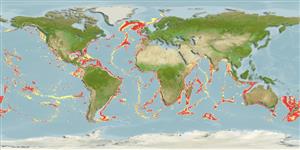>
Notacanthiformes (Halosaurs and deep-sea spiny eels) >
Halosauridae (Halosaurs)
Etymology: Aldrovandia: Taken from Ulisse Aldrovandi, (1522-1605), a Renaissance naturalist and physician noted by his systematic and accurate observations of plants and animals (Ref. 45335).
More on author: Vaillant.
Environment: milieu / climate zone / depth range / distribution range
Ecologia
marinhas bentopelágico; intervalo de profundidade 500 - 2300 m (Ref. 4448). Deep-water
Probably circumglobal. Western Atlantic: New England, USA to Bahamas and off southern Brazil. Eastern Atlantic: northern Portugal to Guinea and off South Africa. Eastern Pacific: Hawaii and Chile (Ref. 9068). Western Indian Ocean: southern India. Eastern Indian Ocean: Western Australia (Ref. 49596).
Tamanho / Peso / Idade
Maturity: Lm ? range ? - ? cm
Max length : 50.0 cm TL macho/indeterminado; (Ref. 27000)
Espinhos dorsais (total) : 1; Raios dorsais moles (total) : 9 - 11. Body light grey in color; head silvery blue on top and sides, darker below and on gill covers (Ref. 3974). Lack of scales on the dorsal surface of the head and short maxillary spine (Ref. 37108).
Found between 530-2321 m, associated with islands and continental slopes (Ref. 58302). Found at bathyal to abyssal depths. Feeds on amphipods, mysids, copepods and polychaetes. Sexually dimorphic, maturing males have enlarged nostrils, anterior nostrils are black and tubular. Females outnumber males 4:1 in western North Atlantic.
Life cycle and mating behavior
Maturities | Reprodução | Spawnings | Egg(s) | Fecundities | Larvas
Sulak, K.J., 1990. Halosauridae. p. 126-132. In J.C. Quero, J.C. Hureau, C. Karrer, A. Post and L. Saldanha (eds.) Check-list of the fishes of the eastern tropical Atlantic (CLOFETA). JNICT, Lisbon; SEI, Paris; and UNESCO, Paris. Vol. 1. (Ref. 4448)
Categoria na Lista Vermelha da IUCN (Ref. 130435)
Ameaça para o homem
Harmless
Utilização humana
Ferramentas
Relatórios especiais
Descarregue XML
Fontes da internet
Estimates based on models
Preferred temperature (Ref.
123201): 2.5 - 8.8, mean 5.3 °C (based on 1006 cells).
Phylogenetic diversity index (Ref.
82804): PD
50 = 0.5156 [Uniqueness, from 0.5 = low to 2.0 = high].
Bayesian length-weight: a=0.00087 (0.00033 - 0.00229), b=3.07 (2.84 - 3.30), in cm total length, based on LWR estimates for this (Sub)family-body shape (Ref.
93245).
Nível Trófico (Ref.
69278): 3.2 ±0.34 se; based on food items.
Resiliência (Ref.
120179): Baixo, tempo mínimo de duplicação da população 4,5 - 14 anos (Assuming tmax>10).
Fishing Vulnerability (Ref.
59153): Moderate vulnerability (40 of 100).
Nutrients (Ref.
124155): Calcium = 11.6 [3.1, 41.9] mg/100g; Iron = 0.349 [0.115, 0.893] mg/100g; Protein = 1.57 [0.00, 5.42] %; Omega3 = 0.309 [0.115, 0.819] g/100g; Selenium = 19.8 [5.9, 73.7] μg/100g; VitaminA = 12.1 [2.3, 60.7] μg/100g; Zinc = 0.424 [0.219, 0.870] mg/100g (wet weight);
